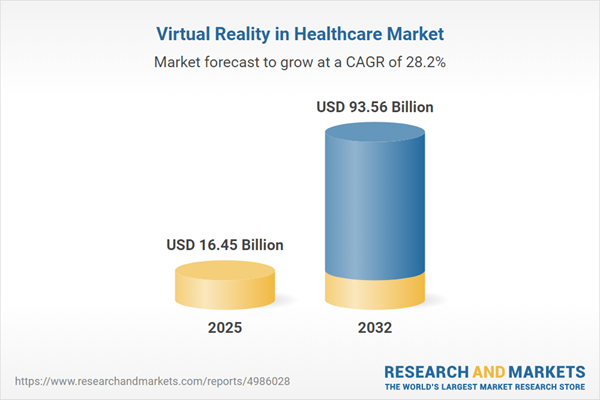Speak directly to the analyst to clarify any post sales queries you may have.
The virtual reality in healthcare market is enabling hospitals and clinical providers to achieve greater operational efficiency, workforce development, and patient engagement through advanced immersive solutions. As digital transformation accelerates across the sector, virtual reality is emerging as a pivotal technology for senior decision-makers shaping future-ready organizations.
Market Snapshot: Virtual Reality in Healthcare Market Growth and Trends
The global virtual reality in healthcare market is currently valued at USD 12.82 billion, with expected expansion to reach USD 93.56 billion by 2032, reflecting a CAGR of 28.19%. Strong market momentum comes from the broader adoption of digital clinical simulations, increased prioritization of patient-centric care, and widespread investment in health IT systems. Healthcare organizations, including hospitals, research institutes, and training centers, are leveraging these solutions to enhance diagnostics, streamline employee training, and support integrated care models. The drive for digital-first strategies is further enabling healthcare providers to proactively respond to evolving clinical and operational demands.
Scope & Segmentation
- Product Types: Immersive virtual reality platforms facilitate simulation-enabled cave systems, employ gesture recognition, and use haptic feedback technologies. These advancements elevate clinical education, support rehabilitation programs, and improve patient and staff engagement in varied healthcare environments.
- Components: Advanced hardware, purpose-built healthcare software, and dedicated VR services facilitate seamless integration into established hospital workflows. These elements drive the broader digital transformation of clinical operations in diverse settings.
- Delivery Modes: Deployment models include cloud-based, on-premise, and hybrid approaches. Each offers healthcare organizations a way to meet stringent regulatory, security, and operational requirements unique to specific clinical contexts.
- Applications: Virtual reality is changing diagnostic imaging, expanding telemedicine capabilities, transforming neuro and orthopedic rehabilitation, enabling surgical simulations, and delivering highly effective training for both clinical and administrative professionals.
- End Users: Hospitals, specialty clinics, telehealth providers, research bodies, rehabilitation centers, and home care services are adopting virtual reality solutions to strengthen care delivery and support operational enhancements throughout the healthcare continuum.
- Regions: Market penetration and return on investment reflect significant regional variation, with the Americas, EMEA, and Asia-Pacific shaped by local regulatory, economic, and innovation landscapes. Tailored market strategies are essential to navigate these differences effectively.
Key Takeaways for Senior Decision-Makers
- Immersive technology broadens the scope for meeting diverse clinical and operational challenges, fostering improved safety and responsiveness for both patients and staff members.
- Incorporating gesture recognition and haptic feedback supports scalable and reliable workforce training, helping organizations sustain clinical standards and drive ongoing skills advancement.
- Modern virtual reality solutions integrate smoothly with established workflows, promoting scalable adoption while aligning with governance and compliance frameworks essential to healthcare delivery.
- Flexible deployment models—covering cloud-based to on-premise and hybrid options—offer IT leaders the adaptability required to manage evolving security, scalability, and policy mandates across healthcare settings.
- Cross-sector partnerships among care providers, technology developers, and academic stakeholders accelerate the transfer of best practices, enhancing return on investment in digital infrastructure and training pathways.
- Sustained investment in immersive platforms keeps organizations ready to address regulatory changes and sector-wide challenges, maintaining a skills pipeline and supporting consistent quality of care.
Tariff Impact: Navigating Hardware and Component Cost Dynamics
The introduction of tariffs affecting essential hardware, such as head-mounted displays, is prompting healthcare organizations to rethink sourcing and procurement strategies. Many providers are minimizing supply chain vulnerabilities by partnering with regional software vendors and domestic equipment suppliers, forming alliances to assure stable access to critical VR hardware. In addition, leveraging shared digital platforms and adopting subscription-based procurement models enables smoother resource allocation and operational consistency, especially within rapidly evolving healthcare environments.
Methodology & Data Sources
This market analysis draws insights from peer-reviewed medical publications, industry market reports, and relevant regulatory documents. Input from healthcare executives and patient representatives grounds these findings in current deployment realities within hospital, research, and training environments.
Why This Report Matters
- Helps healthcare leaders link immersive technology investments to immediate operational needs while supporting the long-term goals of digital transformation across varied care settings.
- Offers actionable recommendations for effective virtual reality implementation, facilitating adaptability as care models and technology standards continue to evolve.
- Enables decision-makers to manage procurement and compliance risks within changing regulatory frameworks, reinforcing operational resilience and preparedness.
Conclusion
Virtual reality is establishing itself as a pillar of operational agility and clinical capability in healthcare. Strategic adoption gives organizations the flexibility and digital strength needed to navigate a dynamic industry landscape.
Additional Product Information:
- Purchase of this report includes 1 year online access with quarterly updates.
- This report can be updated on request. Please contact our Customer Experience team using the Ask a Question widget on our website.
Table of Contents
3. Executive Summary
4. Market Overview
7. Cumulative Impact of Artificial Intelligence 2025
Companies Mentioned
The companies profiled in this Virtual Reality in Healthcare market report include:- Meta Platforms, Inc.
- Microsoft Corporation
- Alphabet Inc.
- Sony Group Corporation
- Apple Inc.
- HTC Corporation
- Siemens Healthineers AG
- Dassault Systèmes SE
- MindMaze SA
- Varjo Technologies Oy
Table Information
| Report Attribute | Details |
|---|---|
| No. of Pages | 185 |
| Published | October 2025 |
| Forecast Period | 2025 - 2032 |
| Estimated Market Value ( USD | $ 16.45 Billion |
| Forecasted Market Value ( USD | $ 93.56 Billion |
| Compound Annual Growth Rate | 28.1% |
| Regions Covered | Global |
| No. of Companies Mentioned | 11 |









